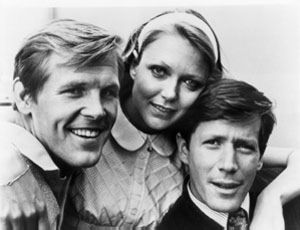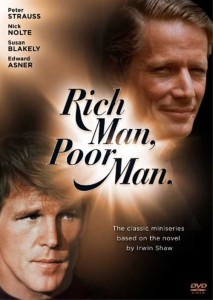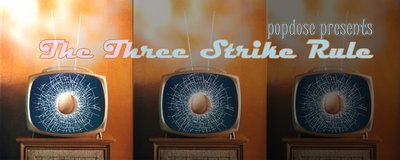The TV minseries is pretty much a phenomenon of the past, especially on the major networks. The only place you’re likely to find this type of long form television is on cable, in particular HBO, which has the revenue to pull off these large undertakings without concern for advertising dollars (think Band of Brothers). With so many forms of episodic entertainment available to people in the 21st century, the major networks have iced miniseries, placing their focus squarely on finding the next BIG show that will keep viewers around for years.
 In 1975, when there were basically three options (ABC, NBC and CBS) for your average family to find original programming, the minseries was a revolutionary idea. The first of the blockbusters miniseries was ABC’s Rich Man, Poor Man. It ushered in a new era of television, one that saw great triumphs (Roots, Shogun, Lonesome Dove) and abysmal wastes of time (pretty much anything with Stephen King’s name attached to it).
In 1975, when there were basically three options (ABC, NBC and CBS) for your average family to find original programming, the minseries was a revolutionary idea. The first of the blockbusters miniseries was ABC’s Rich Man, Poor Man. It ushered in a new era of television, one that saw great triumphs (Roots, Shogun, Lonesome Dove) and abysmal wastes of time (pretty much anything with Stephen King’s name attached to it).
Based upon the bestselling novel by Irwin Shaw, Rich Man, Poor Man was a 12 week television event shown in hour long chapters. The miniseries made stars out of Nick Nolte, Susan Blakely and Peter Strauss, and it featured an all star cast of Hollywood big names, some of them in roles that were basically cameos. Strauss plays Rudy, the ambitious, straight laced good son of a German immigrant baker. As the story opens, it’s VE Day, 1945. The country celebrates the defeat of the Nazis and young Rudy is looking forward to graduating from high school in his small town of Port Phillip, New York and going off to college to study business.
Rudy has a pretty girlfriend, Julie (Blakely), who desperately wants to get out of Port Phillip. She lives with her single mother who struggles to make ends meet. The worst possible fate for Julie would be to end up like her mother and settle for small town life. Julie wants to see the world; she wants to experience life. Although she tries to convince Rudy to run away with her to Greenwich Village, where they can live and get married, he won’t deviate from his plan. This drives Julie away and into the arms of various men and alcohol.
Finally, there is Tom, Rudy’s rebellious younger brother. The bad boy. The ”mistake,” as his mother repeatedly comments. Tom is bored and constantly looking for a thrill. He’s also constantly in trouble with his parents and the law. Although Tom likes to torment his older brother, there is a deep seeded love between the two. They have been raised by a brutish man and a mother who does what she’s told. When given the opportunity to humiliate Rudy and ruin his older brother’s idealized view of Julie, Tom balks, choosing to not hurt him. Tom is played by Nolte, then still an unknown, but displaying every ounce of raw energy and passion that made him one of Hollywood’s most celebrated actors.
The boys have been raised with a strong hand by their ugly, bitter father, a man who drinks his booze like water and despises America, even though the country has sustained him for years. That he fled his homeland after World War I only leads us to believe that he was not an honorable man. He admits as much to Rudy when he describes the horrible circumstances that led to his journey to America. Ed Asner plays this character and makes him as grotesque as possibly, always wearing a scowl and always wearing a wife beater that allows every hair on his arms and back to crawl out from under his clothes.
As with any epic story, the three main characters eventually head off in separate directions. Rudy winds up in college; Julie winds up in New York as an actress, involved with a married man (pre- Hulk Bill Bixby); and Tom winds up on the west coast, having fled New York to avoid the law. Their lives go in diverse directions, but unresolved feelings gnaw at them. After years apart, Julie and Rudy still pine for each other. Meanwhile Tom yearns for reconciliation with his brother. Eventually they all meet again as the miniseries enters into its final hours.
Rich Man, Poor Man could have easily been a cheesy, soap operatic made-for-TV movie, and there are times when some of the older Hollywood stars overact just a little. Even Asner is a little too broad at times. Yet the story moves at a quick pace and remarkably, the editing keeps things flowing naturally, like a book. You don’t notice that the three main characters are on separate trajectories and that their paths don’t intersect for several of the episodes. Anyone familiar with Lost, 24 or any of the current dramas that have multiple storylines should have no problem getting into this series.
The highlight of Rich Man, Poor Man is the acting by the three leads. Strauss subtly transforms Rudy from a needy, goody two shoes to a slick, compromised businessman whose values have gone from black and white to dark gray. Blakely is luminous in the early hours of Julie’s life, when she’s a young ingÁ©nue trying to break away from her small time life. But after a slow descent in alcoholism, Julie becomes a shambles, and Blakely makes this happen marvelously. And then there is Nolte, who is riveting. His youthful face commands the screen. He walks around like a caged tiger ready to pounce, anger and anguish just below the surface. Nolte adds little touches to each scene: a quick, playful wave, a wink, or just a slight smirk that elevates each moment he’s on screen and makes this miniseries extremely enjoyable.
below the surface. Nolte adds little touches to each scene: a quick, playful wave, a wink, or just a slight smirk that elevates each moment he’s on screen and makes this miniseries extremely enjoyable.
Rich Man, Poor Man was a resounding success, garnering huge ratings and numerous awards nominations. Naturally, ABC went to the well again and a sequel was produced. Rich Man, Poor Man, Book II, picks up immediately following the final moments of the original miniseries. Unfortunately, as with most sequels, this second miniseries is bloated and inferior to the first. Double in length, Rich Man, Poor Man, II, suffers from the trappings of most made-for-TV movies. It’s too melodramatic, it’s heavy handed, the direction is flat, and worst of all, it is paced too slowly (probably because they dragged the story out).
Rich Man, Poor Man, Book II continues the story of Rudy and his pursuit of power, in this case becoming a U.S. Senator. Nolte was not a part of the sequel (for obvious reasons once you’ve seen the first) so the secondary stories shifted focus to Rudy’s stepson, Billy (James Carroll Jordan) and Tom’s son, Wesley (Gregg Henry), who has come to live with Rudy. Billy and Wesley are both ambitious and their conflict becomes central to the sequel. Unfortunately, the second miniseries is just not as interesting. What’s really missing is Nolte. His energy was not replaced by any of the new cast members. If Rich Man, Poor Man was prime time, must see television, its sequel is like one of those Sunday afternoon programs you have on in the background while you fold laundry or clean up around the house. You can pretty much follow the plot no matter where you pick up in the story and you don’t feel like you’re missing much when you’re not focused on it.
Rich Man, Poor Man II was 22 hours of television, which is essentially a television season for most regular series. If it had been a regular series, it would have been canceled.
A& E has released a deluxe box set that contains both miniseries in one collection. There are no real bonus features, but the quality of the DVD’s is excellent and having all of he episodes together is nice for fans of both miniseries. Being able to watch every episode back to back is a facintaing feat (and also a bit of a challenge) as you can compare and contrast the two series and make a judgement for yourself.





Comments